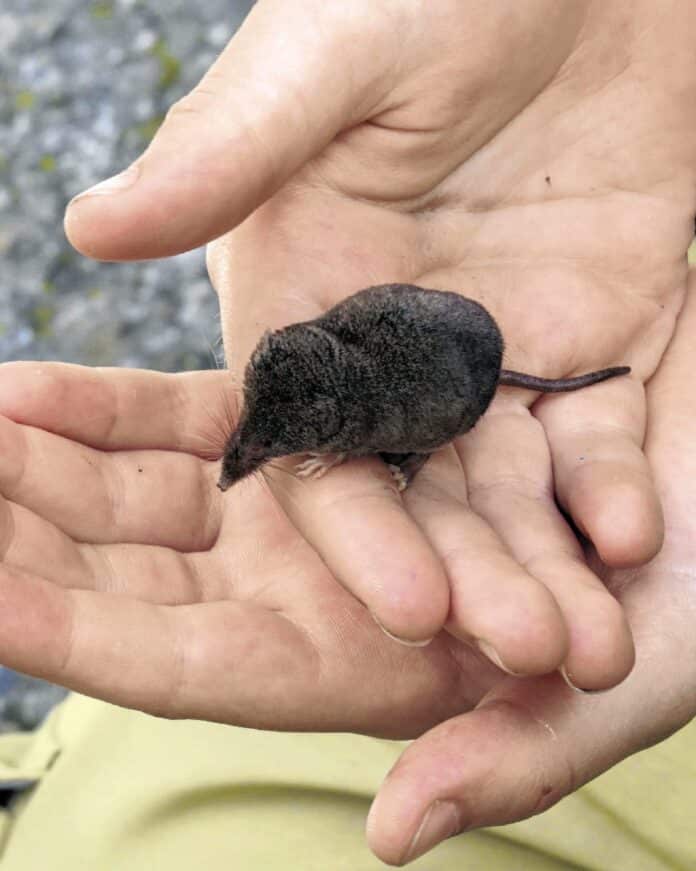
By LESLIE BISHOP, guest columnist
I have always been intrigued with rotting logs in the forest. A grand old tree can fall in a wind storm and in its death continue to support life. As soon as the tree hits the forest floor, decomposers begin to break down the wood and recycle the nutrients into the soil. In the meanwhile, the rotting log serves as a nursery for young plants, as a surface for moss and lichens, as nutrients for mushrooms, and as a home for numerous critters.
But it was only recently that I learned about two rare mammals that depend on rotting logs in our mature southern Indiana forests.
In a bioblitz in the Back Country Area of Morgan Monroe-Yellowwood State Forest, Dr. John Whitaker and Angela Chamberlain of Indiana State University surveyed small mammals. They confirmed the presence of the rare American Pygmy Shrew (Sorex hoyi) and the Smoky Shrew (Sorex fumeus) that depend on large-diameter decaying logs for habitat.
In Indiana, both shrews are limited in distribution to the southern and central unglaciated hills and are ranked as “species of special concern” by the Indiana Department of Natural Resources. These two rare mammals spend their lives on, under and within rotting logs, searching and eating insects and spiders.
[sc:text-divider text-divider-title=”Story continues below gallery” ]All shrews are predators, and because they have such high metabolism, they must eat voraciously all day and all night. They only sleep a few minutes at a time!
A study in Montana found that a pygmy shrew eats three times its body weight daily, which means capturing prey every 15 to 30 minutes. A shrew without food for an hour would die of starvation. A rotting log provides multitudes of termites, ants, beetles and spiders and is the perfect home for a ravenous shrew.
All shrews are small and resemble mice with pointed snouts. But, shrews are not rodents and are classified in a separate mammalian order, the Insectivora. The smallest shrew of all is the American Pygmy Shrew that measures between 1 and 2 inches and weighs barely 0.07 ounces (about the weight of a dime), and thus gets the honor of being North America’s smallest mammal. Dr. Whitaker claims that the American Pygmy Shrew rivals the Bumblebee Bat as the smallest mammal in the world. The Pygmy Shrew’s cousin, Smoky Shrew, is large for a shrew, about 4 inches in length.
Despite their poor eyesight, shrews are efficient predators due to their keen senses of smell and touch. As they poke their long snouts through the decaying detritus of the forest floor, they can smell insect prey and find the location via vibrations through their whiskers.
Scientists who have studied shrews often comment on how noisy they are, with a high-pitched twittering sound. Recent studies have revealed the function of these twitters — shrews use echolocation similar to bats! They are able to use sound waves to examine their surroundings and to analyze the best way to navigate through the habitat.
One researcher observed a “yawning” behavior of a hunting shrew and found that the mouth openings coincide with rapid pulses of low-intensity ultrasounds. No wonder they are such successful predators!
I certainly will look at a rotting log with a new sense of appreciation. Not only do they serve important roles to all the organisms we can see and count, they also provide homes to critters like our shrews that we will probably never see.
In a contemporary popular novel, “The Overstory” by Richard Powers, one of the main characters muses, “I sometimes wonder whether a tree’s real task on Earth isn’t to bulk itself up in preparation to lying dead on the forest floor for a long time.” And now I wonder.
Leslie Bishop is a Brown County resident and retired biology professor from Earlham College. She is a volunteer interpretive naturalist at Brown County State Park. She can be reached through the newspaper at [email protected].




